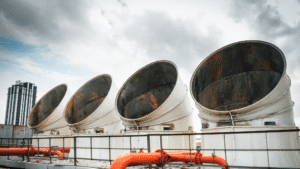Odor in industrial wastewater systems isn’t just a nuisance – it’s often the first signal that something upstream is unstable. Whether it’s caused by organic breakdown, reduced sulfur compounds, or unvented emissions, wastewater odors can lead to regulatory pressure, worker exposure, and persistent complaints from the surrounding community.
Conveyance & sewer system odor control are designed to prevent and manage these odors by targeting the compounds responsible – either before they form, or after they’re released. The goal of these odor control solutions isn’t to mask the problem, but to correct it through chemical and mechanical means.
Facilities that effectively control odors in wastewater treatment , not only reduce risk, they improve biological stability, protect infrastructure, and often save on long-term chemical and maintenance costs.
Where do odors originate?
In most treatment systems, unpleasant smells begin in the anaerobic zones – areas with little to no oxygen. This environment allows certain bacteria to thrive, breaking down organic material in ways that release odorous gases. The most common include:
- Hydrogen sulfide (H₂S) – The most recognizable, often described as smelling like rotten eggs or decayed cabbage.
- Ammonia and nitrogen compounds – Often released from protein breakdown or high-nutrient wastewater.
- Amines and mercaptans – Strong-smelling gases associated with food processing, chemical manufacturing, and pharmaceutical waste.
- Volatile organic compounds (VOCs) – Often from solvents or industrial residues.
These odorous compounds are typically released in early-stage handling: at the headworks, inside equalization tanks, in sludge holding, or during pumping and dewatering. If left unchecked, these gases escape into the surrounding air – causing both operational problems and public concern.
Why odor control matters
When unwanted odors leave the site, the consequences escalate quickly. Wastewater treatment plants and industrial facilities dealing with nuisance odors are more likely to face:
- Odor complaints from nearby residents or businesses
- Regulatory inspections or environmental citations
- Worker discomfort or exposure to foul or harmful vapors
- Corrosion of metal infrastructure due to airborne acids
- Delays in permitting or facility expansion
For plants operating in dense commercial zones or within city limits, effective wastewater odor control isn’t just best practice – it’s mandatory.
Two types of conveyance & sewer system odor control
Most facilities use a combination of two treatment types: liquid-phase odor control and vapor-phase neutralization.
Liquid-phase systems treat odors at the source – before they become a gas. These liquid phase solutions include chemical dosing, pH adjustment, and biological stabilization directly in the wastewater stream.
Applications include:
- Iron or nitrate-based dosing to suppress hydrogen sulfide
- Oxidizing agents to break down odor precursors
- Liquid phase dosing programs that match system flow and odor load
These systems are ideal for force mains, pump stations, and primary treatment stages – especially where odors are forming under the surface.
Vapor-phase systems treat air that has already been contaminated. They disperse neutralizing agents into ambient air, ducted exhaust, or facility perimeters to chemically interact with odor molecules.
Used in:
- Open-air clarifiers or digesters
- Sludge dewatering buildings
- Waste storage areas
- Roof-mounted exhausts or loading bays
Together, these systems create a two-tier defense to prevent odorous compounds where possible, neutralize where necessary.
Also learn about grease trap maintenance and it’s importance in conveyance and & sewer system odor control here.
How to Assess and Select an Odor Control System
No two facilities generate the same odor profile. Before installing equipment or dosing chemicals, it’s critical to first understand what compounds are present, where they form, and how they’re being released.
Step 1: Identify where odors originate
A proper odor control plan begins with source mapping. Odors usually come from a combination of factors:
- High-strength organic loading
- Incomplete mixing or aeration
- Poorly vented tanks or sumps
- Uncontrolled biological zones
Facilities should focus on common trouble spots: sludge storage tanks, primary clarifiers, dewatering areas, pump stations, and headworks. Each of these zones can release different compounds at different times – so visual observation alone isn’t enough.
In some cases, odor complaints from the surrounding community may help pinpoint emission patterns. If nearby areas report unpleasant odors during specific hours or wind conditions, it may suggest a need for perimeter vapor-phase systems.
Step 2: Understand the odor type
Knowing what you’re treating is half the battle. Hydrogen sulfide may require iron or nitrate addition. Amine odors from food or chemical waste may respond better to pH control or targeted neutralization. VOCs and other reduced sulfur compounds require stronger oxidants or activated carbon capture.
A field test or odor panel assessment can confirm whether odors are primarily sulfuric, nitrogen-based, or organic – and which control strategy makes sense.
Selecting and Scaling the Right System
Once you’ve identified where and what, you can configure the how. For example:
- Enclosed lift stations with persistent H₂S? Start with a liquid-phase chemical program.
- A sludge press area generating in-plant odor during operation? Use localized vapor-phase neutralization.
- Open air wastewater treatment basins producing nuisance emissions in summer? Consider dual-treatment with source dosing and ambient control.
Facilities often find the most success by starting with a focused goal – such as reducing odor complaints by 80% – and then adjusting from there. Municipal or industrial applications with stricter permit requirements may need full containment or continuous odor suppression at critical exposure points.
Learn more about ETI’s Odor Control Systems and Grease Trap Maintenance
Monitoring and Ongoing Optimization
Conveyance & sewer system odor control isn’t static. Weather, flow, industrial discharges, and microbial shifts all change over time. The best programs include built-in monitoring:
- Regular odor walk-throughs or community check-ins
- Chemical use tracking and optimization
- Sulfide sensors or air sampling near critical points
- Maintenance of vapor-phase equipment to ensure even distribution
The goal isn’t just to eliminate odor today – it’s to keep it gone next month and next year.
Take Control of Industrial Odors with the Right System
Odor problems don’t go away on their own. If your team is fielding complaints, noticing sulfur buildup, or dealing with foul emissions in working areas, it’s time to take a structured approach to control.
ETI works with facilities to identify odor sources, evaluate site conditions, and build customized programs using liquid-phase or vapor-phase technologies.
Whether your goal is to prevent harmful odors, meet air quality limits, or simply reduce nuisance impact on your staff and neighbors – let’s get your system working better.





